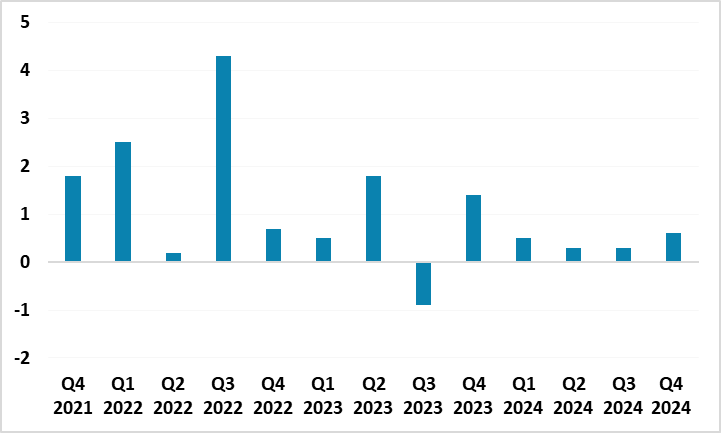South Africa’s Economy Expanded by a Moderate 0.6% in Q4
Bottom line: South African economy grew modestly by 0.6% YoY in Q4 2024 driven by strong performances by agricultural sector and finance. According to Department of Statistics of South Africa (Stats SA) announcement on March 4, demand side of the economy was lifted by household consumption expenditure, which grew 1% QoQ in Q4. We foresee that the growth momentum will continue supported by improved consumer sentiment, lower inflation, and interest rate cuts despite power cuts (loadshedding), which returned back to country’s agenda as of February, will be an important downside risk coupled with uncertain global environment and possible failures in the continuation of structural reforms.
Figure 1: GDP Growth Rate (%, YoY), Q4 2021 – Q4 2024

Source: Continuum Economics
South African economy grew by 0.6% YoY in Q4, bringing full-year growth to 0.6% YoY in 2024. According to Stats SA, the agriculture industry was the main drag on growth on the production (supply) side of the economy, which grew by 17.2% QoQ in Q4. Finance sector was another biggest contributor to growth, expanding by 1.1% QoQ. In contrast, the transport, storage, and communication industry contracted by 1.0% QoQ while manufacturing sector also declined by 0.6% QoQ in Q4, with six out of ten manufacturing divisions reporting negative growth.
Expenditure (demand) side of the economy was lifted by a rise in household consumption spending. Household consumption expenditure, which accounts for about two-thirds of GDP, grew 1% QoQ in Q4. Net exports had almost a neutral impact on GDP, with exports of goods and services rising by 2.1% QoQ and imports increasing by 2.0% QoQ.
The growth was also fuelled by suspended loadshedding in Q4. Eskom announced on February 21 that loadshedding has been suspended for 323 consecutive days, due to bettering planned maintenance, investments in generation recovery, and reduction in unplanned outage. (Note: Despite Eskom previously highlighted that loadshedding will be a thing of the past by March 2025, it appears the loadshedding is back as of February, which could darken 2025 growth trajectory.)
Additionally, an important announcement to watch for 2025 growth will be the annual budget, which Finance Minister Enoch Godongwana will present to lawmakers on March 12, the presidency said. Bloomberg reported on March 4 that the government ministers held a special meeting on March 3 to discuss the best possible options, under the circumstances, to fund the 2025-26 and medium-term plan. A previous spending plan was rejected by members of the coalition over a proposal to raise an additional 191 billion ZAR (USD 10.2 billion) over the next three years by sharply increasing value-added tax.
We envisage that the momentum will continue supported by improved consumer sentiment, lower inflation, interest rate cuts, and we foresee that the economy to expand 1.5% in 2025. There are some downside risks that can negatively impact the growth in the upcoming quarters, which largely relate to the uncertain global environment, and possible failures in the continuation of structural reforms on enhancing infrastructure investments. Uncertainty about the U.S. economy, Trump tariffs, and slowing China demand could cause problems over the growth outlook.